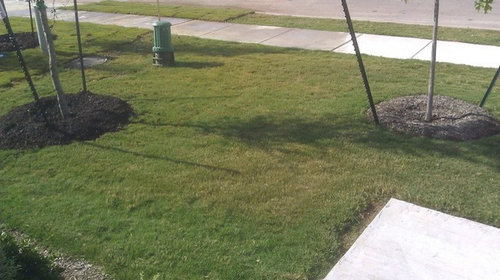My First Lawn!
Brandon0413
11 years ago
Related Stories

MOST POPULARMeet a Lawn Alternative That Works Wonders
Carex can replace turfgrass in any spot, is low maintenance and adjusts easily. Add its good looks and you’ve got a ground cover winner
Full Story
BEFORE AND AFTERSSee 6 Yards Transformed by Losing Their Lawns
Wondering whether a turf lawn is the best use of your outdoor space? These homeowners did, and they found creative alternatives
Full Story
EARTH DAYThe Case for Losing the Traditional Lawn
Work less, help the environment and foster connections by just saying no to typical turf
Full Story
LANDSCAPE DESIGNGet Along With Less Lawn — Ideas to Save Water and Effort
Ditch the mower and lower your water bill while creating a feast for the eyes with diverse plantings and gathering places
Full Story
FRONT YARD IDEASBefore and After: Front Lawn to Prairie Garden
How they did it: Homeowners create a plan, stick to it and keep the neighbors (and wildlife) in mind
Full Story
LANDSCAPE DESIGNCalifornia Says Goodbye to the Sprawling Ornamental Lawn
New state rules will effectively limit turfgrass to 25 percent of the landscape in most new and renovated yards
Full Story
GROUND COVERSGive Your Lawn a Taste of the Wild
Consider the joys of an irregularly trimmed meadow lawn: It’s ecofriendly, visually interesting and still good for romping
Full Story
LANDSCAPE DESIGN15 Great Ideas for a Lawn-Free Yard
End the turf war for good with hardscaping, native grasses and ground covers that save water and are easier to maintain
Full Story
GARDENING GUIDESSmall Gem Lawns: More Impact From Less Grass
Instead of letting the lawn sprawl, make it a shapely design element in your yard. You’ll reap benefits both practical and aesthetic
Full Story
GARDENING GUIDESHow to Plant a New Lawn From Sod
Take the quick-start route to turf with sod; these installation guidelines will help ensure a healthy and long-lasting lawn
Full StoryMore Discussions









Brandon0413Original Author
neilaz
Related Professionals
Bellflower Landscape Architects & Landscape Designers · Forest Acres Landscape Architects & Landscape Designers · Marina Landscape Architects & Landscape Designers · Wheeling Landscape Architects & Landscape Designers · Paradise Landscape Architects & Landscape Designers · Dinuba Landscape Contractors · Downey Landscape Contractors · Fort Hunt Landscape Contractors · Kahului Landscape Contractors · Mahwah Landscape Contractors · Natick Landscape Contractors · Plantation Landscape Contractors · Pleasanton Landscape Contractors · Markham Landscape Contractors · Placerville Swimming Pool BuildersBrandon0413Original Author
nearandwest
neilaz
lou_spicewood_tx
dchall_san_antonio
Brandon0413Original Author
dchall_san_antonio
Brandon0413Original Author
Brandon0413Original Author
Brandon0413Original Author
Brandon0413Original Author
mdameron
dchall_san_antonio